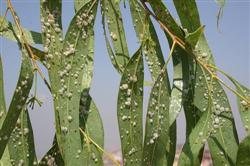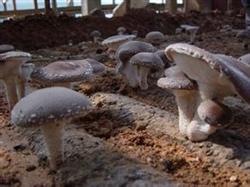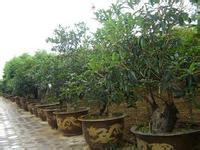Control of diseases and insect pests of eucalyptus

The main diseases and insect pests of eucalyptus are: bacterial wilt, scorch wilt (commonly known as deciduous disease), eucalyptus stem rot, eucalyptus small roll moth, termites, beetles and so on. (1) bacterial wilt: Ralstonia solanacearum of eucalyptus infects young trees in the forest, and its aboveground performance can be divided into two types. The first is acute type, the leaves of diseased plants lose water rapidly and wilt, and the leaves hang on the branches without falling off, showing typical symptoms of "green wilt". For this type of diseased plant, the time from the onset of the disease to the death of the whole plant is relatively short, usually only 2 Mel 3 weeks. The second is the chronic type, the diseased plant shows dysplasia, dwarfism, the lower leaves become purplish red at first, then gradually deepen and develop upward, and finally the leaves dry up and fall off. Irregular black brown death spots appeared in some stems and lateral branches, and the whole plant withered in severe cases. In this type, it takes a long time from the disease of the plant to the death of the whole plant, which is usually 6 months. The epidemic of bacterial wilt of eucalyptus at high temperature and high humidity capacity, root neck damage, surface runoff and root connection between plants are the main ways of invasion and transmission of the pathogen. Prevention and control measures: select disease-resistant strains; do a good job of seedling quarantine out of the nursery to avoid going up the mountain with disease; and try not to build eucalyptus forests on woodlands that are easy to carry bacterial wilt, such as peanuts, tobacco, potatoes, tomatoes, mulberry, kapok, Casuarina equisetifolia and canna, etc.; do not apply immature organic fertilizer; strengthen tending and management to improve the disease resistance of trees. There is no exact and effective control method after the disease of the plant. Once it is found, it can only be uprooted immediately, disinfect the soil with lime and destroy the diseased plant. (2) scorch blight (commonly known as deciduous disease): the disease is a disease caused under the condition of high temperature and humidity, which can make eucalyptus withered branches and leaves, and can be fatal in serious cases, especially Eucalyptus urophylla and its clones are easy to occur in areas with low-lying terrain, poor drainage, high afforestation density and poor forest permeability when they encounter high temperature and rainy weather for more than six or seven days. Prevention and control measures: select land with good drainage for afforestation, low-lying land to do a good job of drainage, planting density should be appropriate, should not be too dense. (3) Eucalyptus stem rot: it is a kind of eucalyptus seedling disease, when the disease occurs, the stem of eucalyptus seedlings rot and die gradually. Prevention and control measures: the seedlings are sprayed with chlorothalonil or chlorothalonil or Bordeaux solution before coming out of the nursery. (4) Eucalyptus small roll moth (Eucalyptus vulgaris): damage young eucalyptus young leaves, damage shoots and top buds, can cause young trees to wither and affect their growth every April-August. Prevention and control measures: (1) artificial kneading. See that there are curly leaves in the young leaves of the young trees, and squeeze the larvae to death with their hands. (2) Pesticide spraying. Spray trichlorfon with a small amount of kerosene or dimethoate 1000 times or pyrethroids (according to the concentration used). (5) termites: it mainly harms the trunk bark of eucalyptus trees and seriously affects the growth of trees. Prevention and control measures: (1) trapping and killing. Bagasse and sugar were buried in the soil to lure termites to concentrate and then killed with pesticides. (2) Drug drive. The effect of killing Metarhizium anisopliae produced by Guangdong Academy of Forestry Sciences is very good. The usage is to mix Beauveria bassiana into a medicine solution according to the instructions, soak the afforestation seedlings into the medicine solution, and then pick up the mountain for afforestation, which can effectively control termites; (3) take drugs and kill them. The application of carbofuran in the soil around young trees can poison termites. Carbofuran can be released alone or in conjunction with other base fertilizers. (6) Beetles: larvae (commonly known as chicken beetles) harm the roots of young trees, especially in some mature fields such as sugarcane and sweet potato fields. Adults harm the leaves of young trees. Prevention and control measures: (1) during afforestation, the turtle larvae can be killed by evenly spreading trichlorfon powder (or tert-butylphosphine 2.5 jin) per mu. (2) spraying 800 times solution diluted with trichlorfon and methamidophos on the leaf surface can effectively kill adults.
- Prev

Key points of summer management of Lentinus edodes
1. Box specifications: made of wooden nails or bamboo strips, locust strips and mountain vines, woven into a rectangular box basket of 50 × 35 × 10 cm, with a nail head or tie head facing outward and covered with plastic film inside. two。 Culture material preparation: mixed sawdust (cottonseed shell or manuscript stalk) 88%, wheat husk or rice bran 8%, corn meal 2%, sugar 1%, gypsum powder 1%, mixed.
- Next

On the Landscape Art of Osmanthus fragrans
Osmanthus fragrans is one of the ten traditional famous flowers in China. It is a special ornamental flower and fragrant tree species in China. Its shape, color, fragrance and rhyme are excellent. Because of its "winter glory of the good osmanthus tree", "do not give up because of the small flowers, elegant fragrance, rich Fu Zhiyuan" and other qualities, it has been favored by literati throughout the ages, and because of its relationship with Chang'e running to the moon.
Related
- Fuxing push coffee new agricultural production and marketing class: lack of small-scale processing plants
- Jujube rice field leisure farm deep ploughing Yilan for five years to create a space for organic food and play
- Nongyu Farm-A trial of organic papaya for brave women with advanced technology
- Four points for attention in the prevention and control of diseases and insect pests of edible fungi
- How to add nutrient solution to Edible Fungi
- Is there any good way to control edible fungus mites?
- Open Inoculation Technology of Edible Fungi
- Is there any clever way to use fertilizer for edible fungus in winter?
- What agents are used to kill the pathogens of edible fungi in the mushroom shed?
- Rapid drying of Edible Fungi

